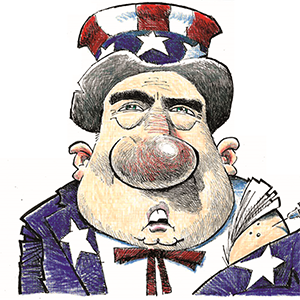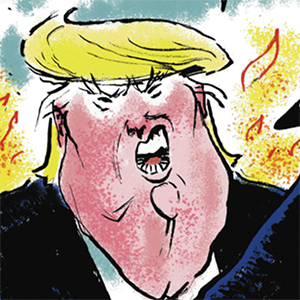Mark Gongloff: The $2 trillion home insurance nightmare is getting even worse
Published in Op Eds
On top of the human tragedy they’re still inflicting, the Los Angeles wildfires are exposing a gap between what people thought their homes were worth and what they’ll actually get from insurance companies when those houses have been reduced to ash. Potentially thousands of homeowners are learning it won’t be nearly enough.
But this isn’t just a Los Angeles problem. From California to Texas, Florida and beyond, parts of the U.S. most susceptible to natural disasters are slowly waking up to an underinsurance nightmare. It’s still ballooning in scope as home values keep rising, people keep crowding onto the front lines of climate change and a heating planet keeps intensifying those disasters.
Four years ago, the total difference between harsh reality and what a site like, say, Zillow suggested homes were worth might have been $1.2 trillion, according to one estimate. Now that estimate has grown to $1.7 trillion. Without better foresight and action from policymakers, mortgage lenders, realtors and homeowners, it will keep growing, potentially to $2.7 trillion.
Dave Burt was one of the lucky investors who saw the 2008 mortgage crisis coming, earning himself not only a big payday but a mention in The Big Short by Michael Lewis. Now he’s the founder and chief executive officer of DeltaTerra Capital, a research firm compiling data on the next housing crisis — this one caused by climate change.
Last year, Burt warned that 17 million U.S. homes, representing nearly 19% of total housing, were underinsured against damage from floods and wildfires alone. The gap between the market value for those homes and their insurance coverage amounted to $1.2 trillion, Burt estimated.
But that figure was based on 2020 market data. The pandemic that began that year inspired a rush out of cities and into houses near scenic sandy beaches or majestic forests. That drove up home prices in parts of the country most vulnerable to floods and wildfires. In a webinar last week, as Los Angeles burned, Burt suggested this pandemic land grab had inflated the climate-exposed housing bubble well beyond his initial estimate.
While home prices in these areas surged 35% between 2020 and 2022, their potential disaster losses rose 41%, Burt said. And even if those homes have avoided catastrophe so far, many property owners are already facing huge increases in insurance prices and other costs that are already eroding their paper housing wealth.
In some markets on the bleeding edge of the climate crisis, the correction has begun. During the pandemic, prices soared 70% in Punta Gorda, Florida, Burt said. Since then, the Gulf Coast town has been hit by three hurricanes in as many years, including Helene, which socked Punta Gorda with Charlotte County’s worst flooding on record.
Uncoincidentally, Punta Gorda topped a recent National Association of Realtors list of metropolitan areas with the biggest year-over-year price declines in the country, falling 6.5%. Neighboring Sarasota and Fort Myers were second and fifth on that list, respectively.
“While the big gains from 2020 to 2022 provide significant room to maneuver for people who owned property at the beginning of run, they provide little solace to a family who put down 20% to buy a new home in 2023 and has already lost half of their home equity because of dramatically increasing homeownership costs,” Burt said in the webinar.
Burt’s new base-case loss estimate of $1.7 trillion assumes policymakers spring into action to address this problem. This would involve not only reforming the entire mortgage market and launching mass disaster-resilience measures but curbing the greenhouse-gas emissions that are heating up the planet and making disasters much worse. This seems … optimistic, especially with climate change denier Donald Trump set to return to the White House.
Burt’s bear case of $2.7 trillion in losses assumes what he calls “a more disorderly unwind” of this climate housing bubble. This feels much closer to reality. Burt suggests we are just two years into what could be a decade-long correction.
Nature will have a say in how quickly this process moves. Los Angeles homeowners caught in the city’s wildfires are already discovering insurance payouts won’t come close to replacing the full value of their homes, the Wall Street Journal reported this weekend. A lot of assumed wealth has gone up in literal smoke, destroying people’s financial security and deflating some of that housing bubble.
The number of U.S. homes in the wildland-urban interface (or WUI), where wildfires are most likely, grew from 30 million to 44 million between 1990 and 2020, according to the U.S. Forest Service. That number almost certainly boomed even further during the pandemic years. Many of these WUI homeowners already face soaring insurance rates, if they can get any at all. For those whose home values have somehow survived such an onslaught, every wildfire will be another opportunity for harsh price discovery.
The size of Burt’s estimated losses relative to the roughly $50 trillion total U.S. housing market may seem almost manageable. But we can’t take these numbers in isolation. For one thing, the proportion of houses facing flood and fire risk in his analysis is significantly higher than those dollar amounts, at nearly one in five U.S. homes. And declining values for homes directly at risk can drag down the values of neighboring homes, too, a Senate Budget Committee report pointed out last month.
What’s more, we all bear the pain of rising insurance costs. Annual U.S. insurance losses doubled from $50 billion to $100 billion between 2011 and 2021, according to a report last month by the U.S. Congress’ Joint Economic Committee. During that time, the average U.S. insurance premium rose 44%. Such costs weigh on housing demand and prices everywhere.
And home insurers aren’t just declining to renew policies in places like California’s WUI or Florida’s Gulf Coast. As the Budget Committee noted, they’re also starting to avoid places like Oklahoma, likely as a result of its exposure to thunderstorms, the destructive power of which has been amplified by climate change.
Montana and New Jersey are among the many other states where insurance nonrenewals are a small but growing problem. This trend is driving homeowners, who must have insurance to get a mortgage, into the arms of state-run insurers of last resort or risky, lightly regulated insurers that tend to offer inadequate coverage.
Put it all together, and you get something that looks an awful lot like systemic risk, threatening home values across the country.
Among the many actions that could avoid financial-crisis-like outcomes are producing better data about disaster risks, and sharing it more widely among lenders, realtors and homeowners. That includes not just updated FEMA flood maps but a better understanding of the fact that, in a new world of hydroclimate whiplash that fuels not only floods but fires, every home is at greater risk than its owners probably realize. The National Flood Insurance Program must be solidified, partly by expanding it to include every U.S. homeowner. Fire and flood resilience measures shouldn’t just be the exclusive right of the wealthy.
Oh, and we should also maybe do something about those aforementioned greenhouse gases. None of this will be easy or even likely, given the current political climate. But the longer we delay, the greater the pain will be.
“There are many parallels to the 2008 crisis here,” Susan Crawford, senior fellow in the Sustainability, Climate, and Geopolitics Program at the Carnegie Endowment for International Peace and author of Charleston: Race, Water, and the Coming Storm, said in the webinar with Burt. “But this time the toxic mortgages are permanent, in essence — these houses are not going to bounce back.”
_____
This column does not necessarily reflect the opinion of the editorial board or Bloomberg LP and its owners.
Mark Gongloff is a Bloomberg Opinion editor and columnist covering climate change. He previously worked for Fortune.com, the Huffington Post and the Wall Street Journal.
_____
©2025 Bloomberg L.P. Visit bloomberg.com/opinion. Distributed by Tribune Content Agency, LLC.




























































Comments